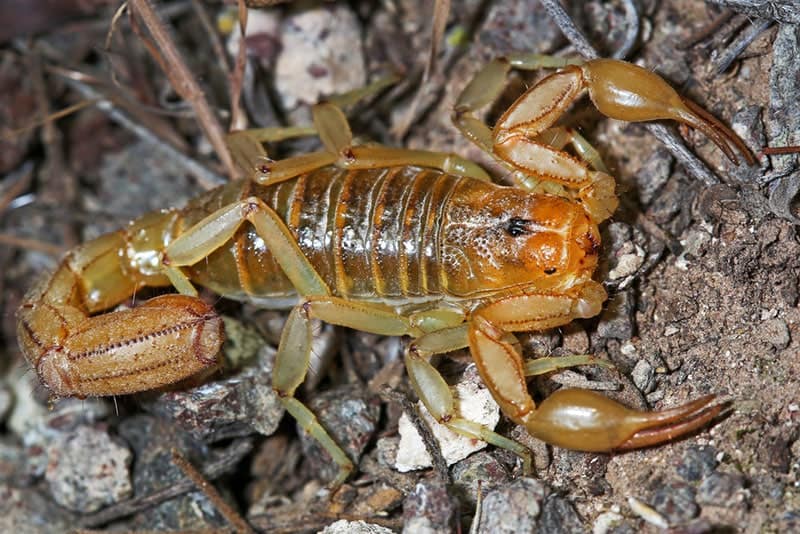New Mexico has a diverse climate and landscape that includes forested mountains and arid deserts, perfect for desert-dwelling species like scorpions. In fact, most of the United States’ scorpion species are found in Arizona, New Mexico, and Nevada.
Only two species of scorpion are found in New Mexico; however, the large populations can make them a nuisance for homeowners with children and pets. Fortunately, scorpions are nocturnal and secretive creatures that prefer to keep their distance from humans. Learn more about the scorpion species commonly found in New Mexico.

The 2 Scorpions Found in New Mexico
1. Arizona Bark Scorpion

| Species: | C. sculpturatus |
| Longevity: | 2-6 years |
| Good to own as a pet?: | No |
| Legal to own?: | Yes |
| Adult size: | 7-8 cm |
| Diet: | Carnivorous |
The Arizona bark scorpion is native to the Sonoran Desert and commonly found in southwestern New Mexico. Measuring about an inch and a half in length, the Arizona bark scorpion is small and light beige in color. Like other scorpions, the Arizona bark scorpion glows under a blacklight and can be easily detected at night with a UV LED flashlight.
This scorpion is nocturnal and well-adapted to the desert, due to its exoskeleton that resists water loss. During the day, the Arizona bark scorpion hides under rocks or wood piles, so they often seek yards and homes to escape the head. These scorpions are one of the few that prefer upside-down orientation and can climb walls or trees.
While many scorpions are only mildly harmful to humans, the Arizona bark scorpion is the most venomous scorpion in North America. When stung, adult humans experience extreme pain, breathing difficulty, and possible death.
2. Stripe-Tailed Scorpion

| Species: | P. spinigerus |
| Longevity: | 2-6 years |
| Good to own as a pet?: | Yes |
| Legal to own?: | Yes |
| Adult size: | 6-8 cm |
| Diet: | Carnivorous |
Also known as the “devil” scorpion, the stripe-tailed scorpion is commonly found in Sonoran Desert of southwestern New Mexico. The stripe-tailed scorpion is a medium-sized species and features brown or tan stripes on the back of its tail. Though the colors and size are similar, the stripe-tailed scorpion’s tail is much thicker than the highly venomous Arizona bark scorpion.
The stripe-tailed scorpion is nocturnal and rarely seen in daylight. To cool down, the scorpion seeks areas to hide, such as rocks, wood piles, sleeping bags, and shoes, and typically prefers humid areas. Its natural diet includes small invertebrates, such as smaller scorpions, crickets, roaches, and mealworms. Many predators feed on these scorpions, including bats, spiders, snakes, centipedes, birds, and small mammals.
Like all scorpion species, the stripe-tailed scorpion is venomous, but poses little risk to humans or most companion animals. Because of this, stripe-tailed scorpions are commonly kept as pets.

Are Scorpions Poisonous?
Technically, no scorpions are poisonous. All scorpions are venomous. Poison is a toxin that gets into the body through swallowing, inhaling, or skin absorption. In nature, poison is more of a defensive maneuver that protects animals from being touched or eaten.
Venom, on the other hand, is a toxin that is injected into the body through a bite or sting, such as the bite of a rattlesnake or the sting of a scorpion’s tail. Venom needs a wound to enter the body and cause damage, so venomous animals may use envenomation as an offensive or defensive attack.
All scorpions are venomous, but the potency of their venom varies. Most scorpions have mildly irritating or painful stings comparable to a bee or wasp, though some species have potentially lethal stings that can affect humans. Scorpion venom is neurotoxic, meaning it affects the nervous system and paralyzes or kills prey.

How to Get Rid of Scorpions
Scorpions are solitary creatures with many predators, so they often stay out of sight. That said, scorpions seek dark places to hide beneath, such as sheds, wood piles, and rocks, and may find their way into yards and basements. Because they’re virtually impossible to control with insecticide, pest-proofing your home is the best way to avoid infestation.
- Avoid leaving garbage, wood, boards, or other attractive scorpion hideaways near your home. Keep bushes and trees trimmed.
- Store firewood outside until you’re ready to burn it.
- Fix cracks and crevices around doors or windows.
- Caulk the edges of roofs, pipes, and other holes and cracks.
Scorpions are skittish and avoid stinging unless provoked, since the action of producing and injecting venom takes a lot of energy. If you startle a scorpion, however, it may sting out of defense. Because the Arizona bark scorpion prefers to be upside down, people are often stung when they move objects and don’t realize the scorpion is hiding on the underside. Always exercise care when moving or organizing wood or clutter around your basement or yard.

Conclusion
Scorpions are abundant in the desert of New Mexico, but fortunately, only a few species are commonly found in the state. Of them, only the Arizona bark scorpion poses a threat to humans and pets. Though you may encounter scorpions from time to time, proper pest-proofing and some precautions can help you avoid an unwanted houseguest or unpleasant sting from startling a scorpion during its daytime nap.
- See Also: 3 Scorpions Found in Utah
Featured Image Credit: Ernie Cooper, Shutterstock
